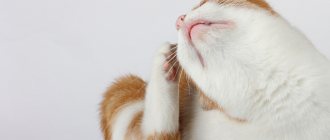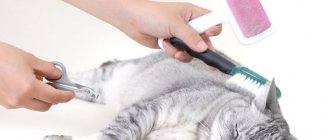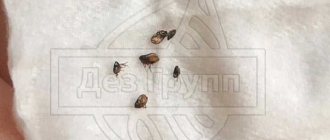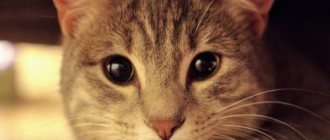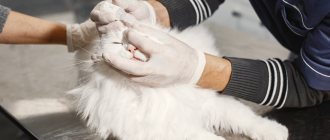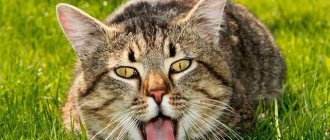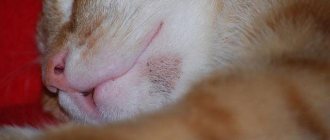For every cat owner, a source of pride is its shiny and beautiful coat. As soon as the cat begins to actively lose its fur, spreading its fur throughout the apartment, especially when the cat's shedding is prolonged, the owners begin to worry. And the cause of concern is not only frequent wet cleaning in the apartment due to the large amount of cat hair, but also whether your pet is sick.
Is shedding normal in a cat or is it one of the symptoms of some disease?
Seasonal shedding. Molting is inherent in all living beings. A cat living in a city apartment is no exception. In the spring, cats change their “coat” in accordance with the growing warmth in nature, and in the fall, with the approach of cold weather, that is, the cat’s owners observe the process of losing and growing new hair. During shedding, the cat behaves as usual, its appetite is preserved, and it does not outwardly look sick. When a cat sheds, it leaves behind a large amount of fur. To keep your pet's coat smooth and fluffy during shedding, try to choose the highest quality premium food. Brush your cat regularly using special brushes and combs. In cats living in city apartments, shedding can last from 2 to 3 months.
Apartment molt . Cats living in an apartment shed all year round, despite good nutrition, absolute health and quality care. Such cats practically do not feel the change of seasons: the molting period in indoor cats stretches for several months, or even the whole year. Indoor shedding intensifies in winter, when the heating starts working in the house or apartment, and the drier the air in the room, the stronger the cat’s shedding. Air conditioners, air humidifiers, and even simple aquariums can partially help owners cope with indoor shedding. For such a cat, owners need to choose suitable food and professional hygiene products (shampoo, conditioner, nourishing masks). Anti-shedding vitamins for cats are effective, but they should not be abused - a maximum of two monthly courses per year.
Baby shedding is the process of changing a kitten's fur to adult fur. Kittens begin to shed at 6 months of age. Molting in kittens continues for 1-2 months. Coarser adult hair grows back, which is thicker and heavier than baby fur. At the same time, the patterned kittens become brighter - the ghostly haze disappears, and the slight fading of the fur, necessary for camouflaging the young, disappears. The dark areas of the skin of Siamese and Burmese become brighter and richer. During a child's coat change, no remedy for shedding cats will help; the owner can only comb the coat daily and make sure that the baby is fed well. The better the living conditions, the faster the coat will change and the more beautiful the adult coat will be.
Pregnancy and feeding kittens . Loss of a significant amount of hair, up to partial baldness, can also be noted in pregnant cats because... During pregnancy, a profound restructuring of metabolism occurs in a cat’s body, and the cat primarily spends the nutrients supplied with food on building the body of the kittens and on their subsequent feeding. After a cat stops feeding her offspring, her coat returns to normal and looks like before pregnancy.
Old age of the cat. Owners often notice thinning fur in older cats around the ears and face. This hair loss does not require special drug treatment; you will need to consult a specialist about feeding an aging cat.
Stressful situations - all animals, including cats, can worry and experience severe nervous overexcitation, which ultimately negatively affects their health, as well as the quality of their coat. A trip to the country, a change of place of residence, the arrival of a new tenant, a fight with its relatives during a walk, meeting a dog, quarrels between family members can become reasons for a cat’s distress. If your pet sheds because of this, then it is important to create a calm atmosphere, surround it with attention and care, and provide sedatives.
Improper grooming is often the reason why a cat sheds all year round. In the case when the cat is clinically healthy, and the change in coat is not pronounced - it sheds little by little and all year round, it is necessary to pay attention to the composition of shampoos, the quality of brushes and other grooming tools. Owners should brush their cat at least once a week: gentle movements with the brush stimulate blood circulation, improving nutrition of the hair follicles and reducing shedding. Shampoos and conditioners must be chosen specifically for cats, and do not forget to dilute them as written on the packaging.
Features of shedding of some cat breeds
Cat breeds such as Persian, Siberian, British and Scottish are among the most shedding breeds. Due to the presence of their undercoat, which is very light and soft, owners get the impression that the cat is constantly shedding. And cat breeds such as Siamese, Singaporean, Bengal, Burmese, due to their lack of undercoat, have low shedding intensity.
Long-haired cat breeds include the American Curl, Turkish Angora, Burmese and Somali.
What should cat owners do if they shed a lot?
If during heavy shedding you do not carefully care for your cat's coat, the fur will begin to tangle and fall out profusely. You will no longer be able to untangle the resulting tangles; the only way out is to cut them out. In the most advanced cases, owners have to cut the cat's hair.
Pet owners can eliminate the unpleasant consequences of heavy shedding in cats by regularly brushing the cat's fur. Pet stores have a large number of special combs for different types of coat. For more effective combing, it is important to choose them correctly.
Introduce into the feeding diet special vitamin complexes that reduce the molting process.
Before purchasing them, you must consult a veterinary specialist at the clinic and do not use the course more often than the course indicated by the specialist.
The use of special hair care products - shampoos, balm and conditioner. All this will help you solve problems associated with shedding in your cat.
The cause of hair loss in a cat is often the presence of one or another disease, one of the symptoms of which is damage to the coat.
Dermatitis is an inflammation of the superficial and deep layers of the skin. Dermatitis in cats very rarely acts as an independent disease; most often, veterinary specialists have to deal with the fact that dermatitis is a symptom of another cat disease.
Depending on the symptoms of dermatitis, it is customary to distinguish:
Superficial dermatitis, accompanied by mild itching, slight redness or rash, and scratching in the cat. The skin may become covered with blisters and ulcers.
Purulent dermatitis, accompanied by ulcers, severe scratching, and skin inflammation. Wet dermatitis, in which the skin appears to be torn off, pus or ichor oozes from it, and the hair around such a wound falls out. Due to constant itching and burning, the cat becomes extremely restless and tears the affected skin until it bleeds.
A cat's coat is often damaged as a result of bacteria or fungi getting into the fur - microsporia, trichophytosis, cat ringworm, dermatophytosis. Inflammation develops quite quickly and can occupy large areas of the skin.
Microsporia (microsporosis, ringworm) is an infectious, fungal disease of the skin and its derivatives, accompanied by superficial inflammation of the skin and hair breaking, as well as damage to the claws. Humans also suffer from microsporia (Human microsporia).
Cats with microsporia are of great epidemiological importance. Cats are a source of infection and the cause of epidemics among people. In cats, lesions in the form of flaky or crusty surfaces are located on the head, near the ears, on the inner surface of the ears, torso, and at the base of the tail. On examination, the hair on the affected areas is of a normal nature, only shorter than the surrounding healthy ones. Such hair can be pulled out easily and painlessly. The base of the hair is covered with a small sheath of fungal spores. The disease in cats occurs in superficial, deep and erased forms.
Among the parasites , hair loss in a cat is caused by the presence of lice eaters, fleas (fleas in a cat), subcutaneous parasites (demodicosis in cats, otodectosis in cats, notoedrosis). Cat's reaction to drug treatment.
When treating a cat with medications, it may develop drug-induced dermatitis, which, in addition to swelling, rashes and redness of the skin, is sometimes accompanied by hair loss.
Diseases of the hormonal system. With hormonal disorders associated with diseases of the thyroid gland, adrenal glands, pancreas (diabetes mellitus in animals), local hair loss occurs. Owners of their cat notice hair loss on the back, belly and tail. When the hormonal system is damaged, a cat becomes lethargic, apathetic, and loses appetite.
The cat has a worm . With helminthic infestation, as a result of weakening of the cat’s body, the cat’s metabolism is disrupted and the immune system is suppressed. One of the symptoms of helminthic infestation will be hair loss (Worms in cats).
Allergy . Hair loss in a cat can be triggered by food allergens in food (food allergy in animals), when in addition to the symptoms characteristic of atopic dermatitis, the cat experiences hair loss (dermatitis in cats).
How to deal with cat hair in an apartment
What to do if a cat sheds and how to remove hair from the floor, furniture and clothes? We will share with you universal methods of dealing with fluff in the house.
How to remove wool from the floor
The main assistant of any cat owner is a vacuum cleaner. Ideally, of course, a robot vacuum cleaner that will do all the work on its own while you enjoy a cup of aromatic tea. A regular vacuum cleaner does just as well, but requires your participation.
Wet cleaning should ideally be done daily, but rubbing with a cloth or waving a mop is very labor-intensive, and a home cleaner equipped with a surface-washing function will help you with this. However, a wet cloth perfectly collects hairs that a vacuum cleaner couldn’t handle. There are also special mops on sale with a rubber coating in the form of a roller that attracts hairs.
How to get rid of wool on a carpet
A turbo brush is the best way to remove wool from carpets. It wraps hairs and makes cleaning much easier. You can also use a stiff brush, but few people like crawling on the carpet on all fours.
How to clean furniture
Use a vacuum cleaner to clean furniture. Brush from top to bottom, first vacuum the shelves, then the fronts of the cabinets, then work on the window sills and only then move on to the beds and sofas.
There is an old but proven method for removing cat hair from upholstery: wet a sheet, cover the chair or sofa and tap it firmly with a beater.
How to remove cat hair from clothes and textiles
How to get rid of wool on clothes? It sticks to all fabrics and glitters treacherously on the street, revealing you as the owner of the cat. Hairs are especially noticeable on dark things.
The easiest way to remove hairs is with a wet palm. Run your hand over the clothing from top to bottom, rolling the wool into balls.
Use sticky rollers to clean things, choose reusable solid gel rollers to save your family budget. They can be washed with water.
To reduce static, wash clothes with conditioner or treat them with an antistatic agent. Keep closets closed and clothes hidden in covers.
Diagnosis of hair loss
Only a veterinarian can correctly determine the reason why your cat is shedding excessively. To do this, you will have to contact your veterinary clinic.
At the veterinary clinic, the veterinarian will give your cat:
- Clinical examination, during which the cat's skin, ears and mucous membranes will be carefully examined.
- He will collect a medical history from you (how the hair loss progressed, are there any additional symptoms of the disease that could cause hair loss in the cat).
- They will do blood tests (for hormones, to rule out allergies, infectious diseases).
- A scraping will be taken from the affected areas of the epidermis, followed by a microbiological examination of the hair follicles.
- If necessary, X-ray examination and ultrasound will be performed.
Based on the diagnostic studies performed, the cause of hair loss and severe shedding of your pet will be determined.
Adjusting the diet
Main mistake
Overfeeding is the most common feeding mistake made around the world. Don't feel guilty about the fact that your cat's bowl is sometimes empty. A constant buffet leads to an increase in the calorie content of the daily diet and, naturally, to obesity. Even an absolutely not hungry cat will definitely not leave food for tomorrow if it can be eaten today.
How to calculate a portion
The calorie content is always indicated on the packaging of ready-made food, which is why portioned wet food in bags of 80-85 grams is very convenient. If you combine them with a dry diet, then 2 sachets per day will be enough.
Among the brands for cats there are those with a wide range of flavors, for example. This is very important because every pet needs variety. Thanks to the large number of flavors, there is no need to change the diet from one brand to another, which means you can always offer your cat something new without consequences for digestion.
Sheba has 2 wet food formats: 85 gram pouches and 80 gram metal jar. In total, pouches and jars are presented in 13 exquisite flavors - double and mono. The average calorie content of one spider is 55 Kcal. If your cat weighs 4 kg, then 2 Sheba spiders will be enough, as well as 2 small portions of a dry diet. If you choose only wet food, then 4 bags per day will cover her calorie needs.
Caloric intake for a cat: 50-60 kcal per 1 kg of weight per day. All types of food should be taken into account here - both dry and wet.
There is a very convenient life hack for dry diets:
● Determine the daily portion of dry food using a kitchen scale - you only need to do this once.
● Divide the resulting portion into 2 parts by weight.
● Select a measuring spoon from among the kitchen utensils that will hold exactly half of the daily volume of dry food and apply food only with this spoon 2 times a day.
Both wet and dry food can be given in more than just the usual bowl. Use educational toys that can hold your cat's food. Thus, the process will be longer and more interesting, as it will satisfy the cat’s instinctive need to hunt and obtain food.
Treatment
Having made a diagnosis, the veterinarian prescribes treatment. It will be aimed at restoring the coat, as well as eliminating the cause of hair loss in the cat.
Treatment methods:
- If the problem of hair loss is associated with an allergic reaction of the cat to certain allergens, the animal must be completely protected from this allergen. After this, medications are prescribed to enhance immunity. If the allergy is caused by food, then it is necessary to put the cat on a hypoallergenic diet.
- For skin lesions caused by ectoparasites (ticks, fleas and lice), a veterinarian will prescribe special antiparasitic drugs (fleas in a cat). You will need to include vitamins and nutritional supplements in your diet to strengthen your cat’s immunity.
- If hair loss on the cat’s body appears as a result of an infectious disease, monovalent and associated vaccines against microsporia and trichophytosis are used - Mikkanis, Vakderm, Vakderm-F, Microderm, Polivak-, Pushnovak, etc.
When treating ringworm, veterinary specialists also use medications such as: Ketoconazole, Itraconazole, Griseofulfin, and so on. In this case, it is recommended to use immunosupportive agents and medications to improve metabolism. It is important to remember that ringworm is transmitted to humans.
- Hair loss caused by stress in cats is treated with special calming medications.
- Treatment of hair loss caused by subcutaneous parasites is described in our articles - demodicosis in cats, otodectosis in cats, notoedrosis.
- For endocrine disorders in a cat's body, hormonal medications are prescribed.
Tips and tricks for pet owners
We have collected tips for caring for cats that will make your life easier:
- Provide your pet with a place to sleep, eat, and go to the toilet. Buy bowls for water and food, as well as a mat for them, as some cats eat sloppily, spilling water and scattering food on the floor. Place the house and scratching post in the corner of the room.
- Bathe your cat once every 3-6 months if she does not go outside for walks. If your pet is free-range, you will have to bathe it more often, because dust, dirt, and dry grass stick to its coat. The optimal water temperature is 38-38.5°C. Long-haired cats can be blow-dried on low setting.
- Brush short-haired cats once a week, or several times during the shedding period. Brush long-haired cats daily and trim mats if necessary. Remember, the softer the fur, the softer the brush, and vice versa.
- Trim the nails once every 2 weeks with a nail clipper, being careful not to catch a blood vessel.
- Clean your eyes and nose daily with a damp cloth or swab. If purulent discharge appears, contact your veterinarian.
- Clean your ears with a special lotion once a week. Earwax should be light in color and without an unpleasant odor; if it is darkened and smells bad, take your pet to the veterinary clinic.
- If there is no solid food in the diet, the cat needs to brush its teeth from plaque and tartar once a week with toothpaste for cats.
- Once every three months, it is necessary to show the animal to a veterinarian and promptly vaccinate. A specialist will examine your pet and be able to identify serious diseases in time. 10 days before vaccination, treat for worms.
Prevention
In order to prevent hair loss in cats, owners must take a number of preventive measures. Such measures will preserve the cat’s skin and prevent the development of more serious diseases.
Prevention of hair loss, heavy shedding and baldness in cats includes:
- Timely and regular vaccination against infectious diseases common in your region.
- Proper care of the animal's fur.
- Regular treatment of the skin against ectoparasites
- Periodic deworming against worms.
- During a walk, try to protect the cat from contact with sick and stray animals.
- Create favorable living conditions for the cat in the apartment.
- Feed with a balanced diet rich in vitamins.
- Protect your cat from possible stress.
- Conduct regular preventive examinations at your veterinary clinic.
Possible causes of itching
If a cat is constantly itching during examination at the RosVet EC, the following must be excluded/confirmed:
- inflammation of the paraanal glands;
- helminths;
- kidney disease, liver disease and changes in the functioning of the endocrine system;
- otitis;
- marginal seborrhea of the auricles;
- hormonal disorders.
It is important to know! Cats are very susceptible to stress. Behind external equanimity lies a subtle and vulnerable soul, and any psychological discomfort can result in the development of psychogenic itching. OCRD (OCD) is considered an exclusionary diagnosis; behavioral obsessive-compulsive disorder is expressed in the constant habit of scratching and biting oneself. This is a psychological dependence on the process itself, from boredom, the paws and tail suffer (it gets chewed off).
